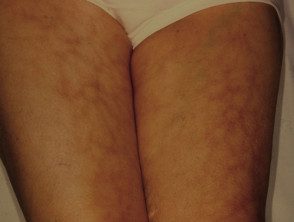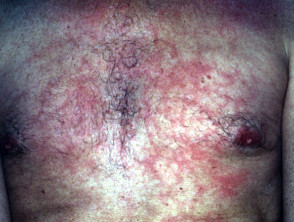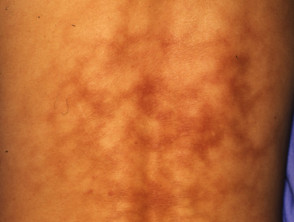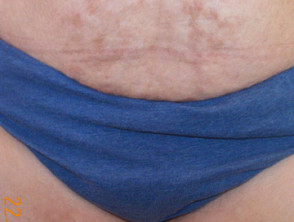What is erythema ab igne?
Erythema ab igne (EAI) is a skin reaction caused by chronic exposure to infrared radiation in the form of heat. It was once a common condition seen in the elderly who stood or sat closely to open fires or electric space heaters. Although the introduction of central heating has reduced EAI of this type, it is still found in individuals exposed to heat from other sources.
What are the signs and symptoms of erythema ab igne and who is at risk?
Limited exposure to heat, insufficient to cause a direct burn, causes a mild and transient red rash resembling lacework or a fishing net. Prolonged and repeated exposure causes a marked redness and colouring of the skin (hyper- or hypo-pigmentation). The skin and underlying tissue may start to thin (atrophy) and rarely sores may develop. Some patients may complain of mild itchiness and a burning sensation.
Erythema ab igne
Localised lesions seen today reflect the different sources of heat that people may be exposed to. Examples include:
- Repeated application of hot water bottles or heat pads to treat chronic pain, e.g. chronic backache
- Repeated exposure to car heaters or furniture with built-in heaters
- Occupational hazard for silversmiths and jewellers (face exposed to heat), bakers and chefs (arms)
What treatments are available for erythema ab igne?
The source of chronic heat exposure must be avoided. If the area is only mildly affected with slight redness, the condition will resolve by itself over several months. If the condition is severe and the skin pigmented and atrophic, resolution is unlikely. In this case, there is a possibility that squamous cell carcinomas may form. If there is a persistent sore that doesn't heal or a growing lump within the rash, a skin biopsy should be performed to rule out the possibility of skin cancer. Abnormally pigmented skin may persist for years. Treatment with topical tretinoin or laser may improve the appearance.



